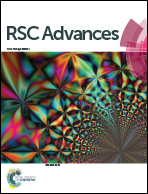Folate decorated delivery of self assembled betulinic acid nano fibers: a biocompatible anti-leukemic therapy†
Abstract
The objective of this study was to develop folate receptor mediated delivery of self assembled betulinic acid nano fibers (SA-BA) to human leukemic cells and to investigate their specific induction of apoptosis. The physicochemical properties of PEG conjugated SA-BA followed by conjugated with folic acid (FA–PEG–SA-BA) were examined using Fourier transform infrared spectroscopy, thermogravimetry analysis, X-ray diffraction analysis, thin layer chromatography and scanning electron microscopy. The stability of folic acid with PEG–SA-BA conjugate was higher at acidic pH, which helps to maintain the conjugate structure for internalization of folate receptor over expressing cells. FA–PEG–SA-BA showed good compatibility with normal cells. The internalization of FA–PEG–SA-BA was significantly observed in folate receptor over expressing K562 cells while showing comparatively lower impact on folate receptor lower expressing KG-1A cells. This intracellular localization of conjugate facilitated the generation of excess reactive oxygen species (ROS), followed by elevation of tumor necrosis factor alpha (TNF-α) secretion. The effective contribution of ROS and TNF-α in FA–PEG–SA-BA mediated leukemic cell death was confirmed by pretreatment of cells with the ROS scavenger (N-acetyl-L-cysteine) and pentoxifylline, a potent TNF-α blocker. The mode of leukemic cell death was confirmed by flow-cytometric analysis. We also tested the possible involvement of caspase activation in TNF-α mediated leukemic cell death by immunoflouroscence staining of apoptotic marker proteins (caspase 8 and caspase 3).


 Please wait while we load your content...
Please wait while we load your content...